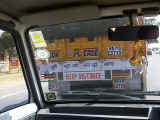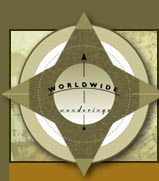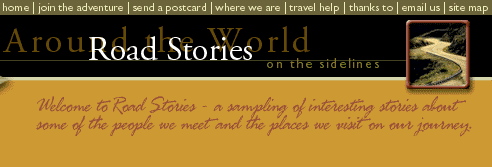|
 On the Road in Northern India
"Warning: Due to poor
road conditions and aggressive driving, road travel in India is dangerous." - - Let's
Go Guide to India and Nepal On the Road in Northern India
"Warning: Due to poor
road conditions and aggressive driving, road travel in India is dangerous." - - Let's
Go Guide to India and Nepal
These are probably the most accurate, yet understated words in the
entire 800 page guide, words that rang truer and truer with each passing kilometer of our
hairy-scary roadtrip across Northern India. Sure, we could've taken trains. Sure, we
could've taken planes. But to truely see, feel, and experience the real India, we
choose to ride her highways. Yep, the real India - every bump, pothole, swerve, and
curve - with the help of our driver Ramb (and our little, in his words,
"Japaneeeseee" mini-bus) we covered over 1,500 kilometers of them (almost 1,000
miles). From Delhi to Jaipur, to Pushkar then Agra, Khajuraho, and finally Varanasi, just
the three of us and the not-so-open highway.
I guess it could be the warning in the Let's Go guide that has me
slightly more than just a little apprehensive about our choice of transit for the next 10
days. Or maybe it's the words of one of the headlines from that morning's paper that read:
"11 Killed, 40 Hurt In Traffic Mishap" that I find a bit disconcerting. Or I
suppose it could be that I find it a tad unnerving that the government feels they have to
stencil a big 'relax' across lens of the red lights on the traffic signals (like the one
that we've just pulled up to) just to remind India's drivers to chill-out as to not kill
themselves or anyone else.
Maybe it's something as simple as too much coffee this morning, or
possibly a combination of all the above, that's giving me the jitters as we start out
early for Jaipur. The roadways, like the rest of India's infrastructure, were designed and
built by the British. So the Indians, like the Brits, drive on the 'wrong' side of the
road. Well, actually they drive on both the 'right' and 'wrong', or 'right' and 'left'
side of the road, depending on how you look at it. It seems that either of the roadway's
two lanes is fair game for anyone, driving anything, in any direction, and at any speed.
And, you don't have to be a Traffic Commissioner to figure out that things get a little
crazy with meandering pedestrians balancing baskets on their heads; camel drawn buggies
rolling wobbily along; tiny motor scooters straining beneath the weight of four
generations of riders (grandfather, father, son, and grandson, all on the same time); huge
Tata transports loaded so high that they look like they might tip at any second; and
lastly, little vans like ours darting quickly in and out of this other traffic; all
sharing the same two lanes of bumpy asphalt. For us, the whole thing translates into
dodging slower moving carts and people, while at the same time playing 'chicken' with 10
ton trucks, all at 50 mph, 10-12 times each hour, for 7-8 hours a day.
Merely being a passenger is a stressful, exhausting proposition. But
being a driver, well that requires absolute nerves of steel behind the wheel. After just a
few hours, we've had countless 'close' calls, but Ramb, our driver, has yet to as much as
flinch. In fact, one such 'two headed this way, two headed that way, bound to be a head-on
with only two lanes to share' event is just too much for Laura. She lets out a sharp
"Ahh, watch out!!", then clinches her eyes and buries her head in her hands.
Ramb calmly responds with "Ooo, hello Mr. Bus, heh, heh" just as he jerks us
back into our lane with less than a coat paint for his margin of error.
An hour or so later, as we pass a huge government sponsored billboard
that reads: 'Haste Is Life's Greatest Assassin', Ramb blurts out "this place, dead
bodies". We whiz past the cemetery and I have to wonder how many of them end up here
because they ignore such billboards, and meet their hasteful demise on India's highways.
My next thought is wondering how many of them were tourists, simply tootering along in
their little minibuses when . . . .
A bit farther down the road, we pass by another little roadway behavior
reminder in big white letters. This one screams: 'Better late then never'. Unfortunately,
it also probably goes largely ignored, as evidenced by the average of one smashed,
crashed, or overturned Tata truck that we pass for each hour that we're on the road. Ah,
the Tata trucks, those giant monsters of the road, their fronts colorfully decorated with
curls and twirls, bursts and flowers, and their backs hand painted with instructions for
passing drivers such as: 'Keep Horn OK Please Distance' (read from the outside to middle:
keep your distance, honk horn when ready to pass, I'll tap my brake lights when it's
O.K.). And 'Use Dipper at Night' (read: at night, dim your lights when ready to pass).
Also, 'Powar Brek' (read: stay back, I've got special power brakes that let me stop faster
than you can).
Aside from the brightly painted Tata trucks, there's also the
wonderfully colorful apparitions floating alongside, and across, the dusty roadway, and
intermittently stealing our attentions. They are the women of India, adorned in their
graceful, flowing, salwar kameez's that glow brilliantly in the sun. Unfortunately, the
expressively decorated Tatas and salwar kameez clad women are just some of the many images
that I'm able to capture and hold only in my mind's eye. These, and countless others, like
the mangy mutt riding down the road atop a camel like he's king of the caravan; or the old
man getting a trim and a shave in a 'barber shop' that's actually a wobbly chair in front
of a mirror hung under shade tree; pictures like the one lone construction worker laying
pipe, while ten others, obsessively curious, stop for hours to watch him; or the cartload
of women laying their heads patiently on their arms, waiting for eternity as the men work
furiously to fix a flat; all of these images popped up, then quickly sped into the dusty
distance behind us, before I could even think of grabbing my camera. This 'too quick for
the shutter' passing is why a day of driving India's roadways is sometimes so frustrating,
but also rather rewarding.
For instance, even though after a day's motoring, my unsharable mental
snapshots far outnumber my showable digital photos, I do have quite a collection of
interesting knots on my head from the many humps and bumps along the way (until I figure
out that I if I slump down in the seat I only get a sore back instead of a lumpy head).
And not only that, but our 4/40 air conditioning (open 4 windows at 40 mph) has left an
impressively thick and sticky film covering my whole body - a nice mixture of sweat, dirt,
and carbon from all the truck exhaust. As an added bonus, I end each day with my mouth so
dry that it feels like there's a hole in it's roof, and with a set of lips that taste
remarkably like I've spent the day sucking on sticks of white chalk. But the biggest
blessing of all is that using a little caution amidst the chaos means that we've lived to
tell our tale of another day on India's highways. For, like the sign just ahead says:
'Safe driving takes you to tomorrow'.
|



